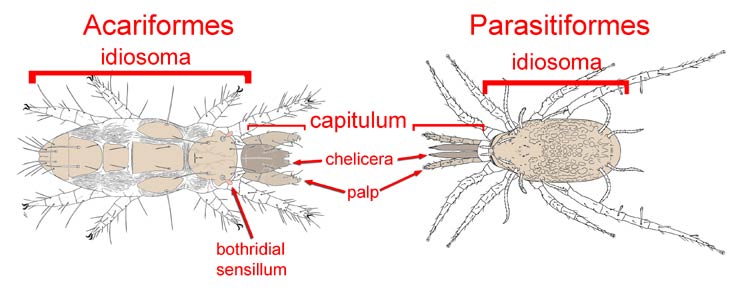|
Common names: mites, ticks
Probability
of encounter: high
Quarantine
importance: numerous important pests of crops, livestock, wildlife, native
flora, and humans.
Taxa
most similar
to mites: Ricinuleids have a cucullus
and opisthosomal segmentation. Opilionids have
opisthosomal segmentation.
Morphology
- Normal
adult length: <1
mm, range 0.080 - 20 mm
Body tagmata: capitulum (= gnathosoma), idiosoma
Eyes: +/- 1-2 median ocelli; +/- 1-2 pairs lateral ocelli
Antennae: absent
Mouthparts: 2-3 segmented chelicerae; pedipalps (palps) with 1-5 free
segments; pedipalpal coxae fused into subcapitulum
Legs: 1-4 pairs, typically 3 pairs in larvae, 4 pairs in nymphs and
adults (rarely 2 pairs, 1 pair)
Distinguishing features: capitulum, loss of visible body segmentation
-
Diversity:
2-3 superorders, 5-6 orders, 450-500 families: 55,000 described species, >1,000,000
spp.
References
Tree of Life -
http://tolweb.org/tree?group=Acari&contgroup=Arachnida
Krantz, G.W. 1978. A Manual of Acarology. Oregon State
University Bookstores: Corvallis.
Walter, D.E. and Proctor, H.C. 1999. Mites:
Ecology, Evolution and Behaviour. University of NSW Press, Sydney and CABI,
Wallingford.
Mite Classification
- The Acari: a Taxonomic Framework
